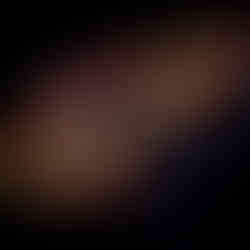At Sterling Hill, most collectors highly favor searching with short wave UV, ignoring long wave almost entirely. That's too bad because there is plenty to find under strong LW. A great example is the rock pictured here. It's an 11lb, 10oz monster that is 7.5" x 7.5" x 5". Hard to miss, you might think. But searching with only SW UV, everybody passed right over it since it looked like a nondescript hunk of calcite. When they saw it glow under 365nm, they exclaimed, "Where did you find THAT!?" I said, "You stepped on it". Using my powerful LW LED flashlight, I was able to find a lot of this stuff. It's a very rich example of orange and pink Sphalerite and the bright blue variety of the same called Cleiophane. But mixed in is a healthy helping of the aforementioned, YFC, or Yellow-Fluorescing Calcite. A great, 2001 article about the mineral was written by James Van Fleet and Dr. Earl Verbeek. See: https://works.bepress.com/james_vanfleet/5/
Though it always occurs as thinly scattered wisps and, to my experience, is always associated with the Sphalerite, the YFC is quite bright. The secret to seeing it is to use a powerful, true 365nm LED flashlight, as used for the LW photo here. Common tube-based LW, filtered UV will work but the response is muted enough that one could miss the YFC. Indeed, everyone using SW only in the field and not powerful, LED-based LW is what allowed me to see all of the fabulous Sphalerite they missed and then afterwards notice that this mysterious bright yellow mineral was also present. Since this was originally posted, the Convoy has come into being and powerful 365nm UV is commonplace now.
In the photos, I have used a program to remove dust and other fluorescing particles clinging permanently to the black felt I use as background. But the colors and brilliance have not been altered and what you see is how the rock appears to the eye. Lacking fancy photo-stacking ability, I take my shots with a 15-second open shutter and hand-bracket the exposures to arrive at a best result (covering the lens when I want to stop the exposure). Allowing the camera to remain on, "auto" is easiest for me. Using the bright LED UV, exposures are quick, in the range of a half-second before overexposure occurs.








